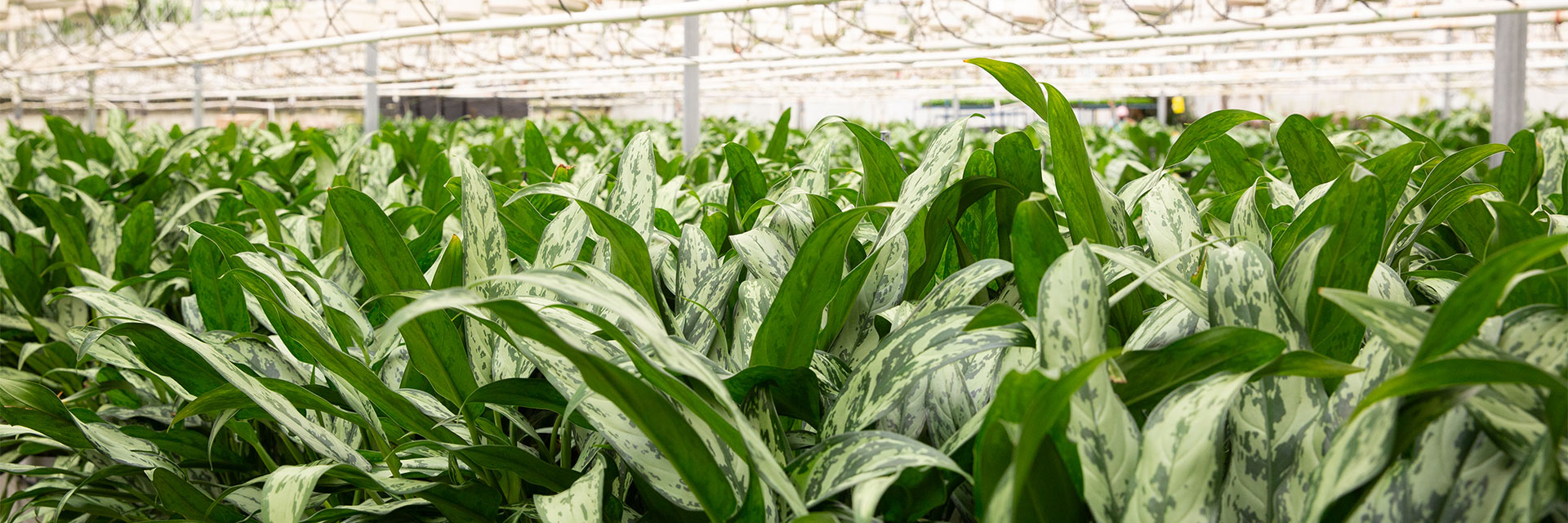
As suppliers to interiorscapers, we define an interiorscape grade plant as a beautifully manicured plant. A plant that is disease and pest free, has a robust root system that will be able to withstand stress of a low light interior, and has a finished natural look.
For a grower to achieve this goal means an investment in time, labor, and inputs.
YES, we do!
As humans, we have biophilia – an affinity for nature and being around natural things. We are nature-loving, yet indoor dwelling. Having indoor plants is a way to bring the outdoors in allowing you to enhance your space. Being surrounded by indoor plants, people become more productive and more creative – making them great homework helpers for kids. Some plants remove various volatile organic chemicals enhancing the air we breathe. They add humidity to the air when it is dry and absorb the excess humidity when it is too wet. Providing a healthy environment for people while connecting them to nature.
There is a wide assortment of plants out there to decorate with whether your style is casual, traditional, rustic, contemporary, tropical, or just zen. Decorating with plants can be a form of self-expression as well as a form of art. Indeed, green walls are even a form of art on the wall.
Have fun, enjoy plants, and celebrate bringing nature indoors.
We send out a weekly availability (sign-up for our weekly availability) normally on Thursdays. We have a series of checks with pluses and minuses indicating if we have ample or limited numbers available. You may also see notes indicating if the plants are Short (S), Medium (M), Small (SM), Tall (T), if they have runners that are Short (SR), Medium (MR), or Long (LR). On the Bromeliads, we will also indicate color stage – Low (L), Medium (M), and Medium-High (MH). We recommend MH color plants that are intended to go immediately into indoor environments. We also have notes on which plants we find particularly Nice.
For next day service, orders will need to be placed the morning before the order is to be picked-up or delivered, preferably by 10am. Certainly, we will take your orders sooner. The more time you give us, the more time we have to select and prepare your plants for shipment. We are happy to take pre-orders to ensure we will have your plants available for any special orders or interiorscape change-outs. Plants are selected, cleaned, sleeved, and packed the day before the shipment arrives to ensure freshness. We have multiple dock locations to accommodate various sized trucks and orders. We are able to accommodate 53’ trailers. Our experienced crew will efficiently stack our boxes in your truck maximizing space and promptly get your truck back on the road.
Rather than looking for varieties that are inexpensive and turn quickly on the bench, our goal is to select varieties that hold up well in the home and office. We are always looking out for new and improved varieties that may offer better disease resistance, a distinctive look, grows better in our greenhouse, or holds up better indoors. Sometimes it might take a few years to get the first trial started and additional time to build production numbers. Whether or not we will start producing this variety will be determined by how it does in our greenhouse conditions, how it holds up in shipping, and how it holds up in our homes and office. Often we need to commit to numbers with our suppliers before we know our customer demand.
It is important to build a larger root system so the plant has more reserve energy. This reserve energy will help sustain the plant when it is exposed to less than optimum light, watering, temperature, and/or humidity conditions. If the plant is sent out as soon as the roots start to form, it has less of a chance of success than a well formed plant that had ample times to allow the full development of it’s root system.
Our plants are acclimated to greenhouse temperature range of 68F to 85F, exposure to temperatures outside of this range will cause stress. When transplanting plants over long distances, it is important the temperature be kept between 55F and 60F. At warmer temperatures, the plants will produce gasses causing which can cause the foliage to wilt and the plant to deteriorate. Upon arrival, plants should be unsleeved immediately to reduce the build-up of gasses in the sleeves. The plants will experience stress coming from a cool, dark truck to a hot environment. It is best to smooth the plants transition from these differing environments. If the plants are normally kept in a greenhouse and the greenhouse is experiencing warm summer conditions, you may want to consider holding them in a low light, cool area and waiting to place your plants in the greenhouse towards the end of the day when the conditions are cooler.
For short day trips, precautions should be taken to prevent the plants from being exposed to the stress of heat and limited air movement. Leaf temperatures need to be kept below 96F. If plants are next to something that is hot (floorboards or side walls), it will transfer heat faster. Insulated flooring, walls, and ceilings of your transport vehicle is important. Also, consider transporting plants in the morning when the temperatures are cooler. Do not allow plants to sit in a closed hot vehicle, this will reduce to longevity of your plant. Make sure the plants are kept away from direct sunlight. If transporting in a vehicle with windows, a white sheet on top of the plants will provide additional protection.